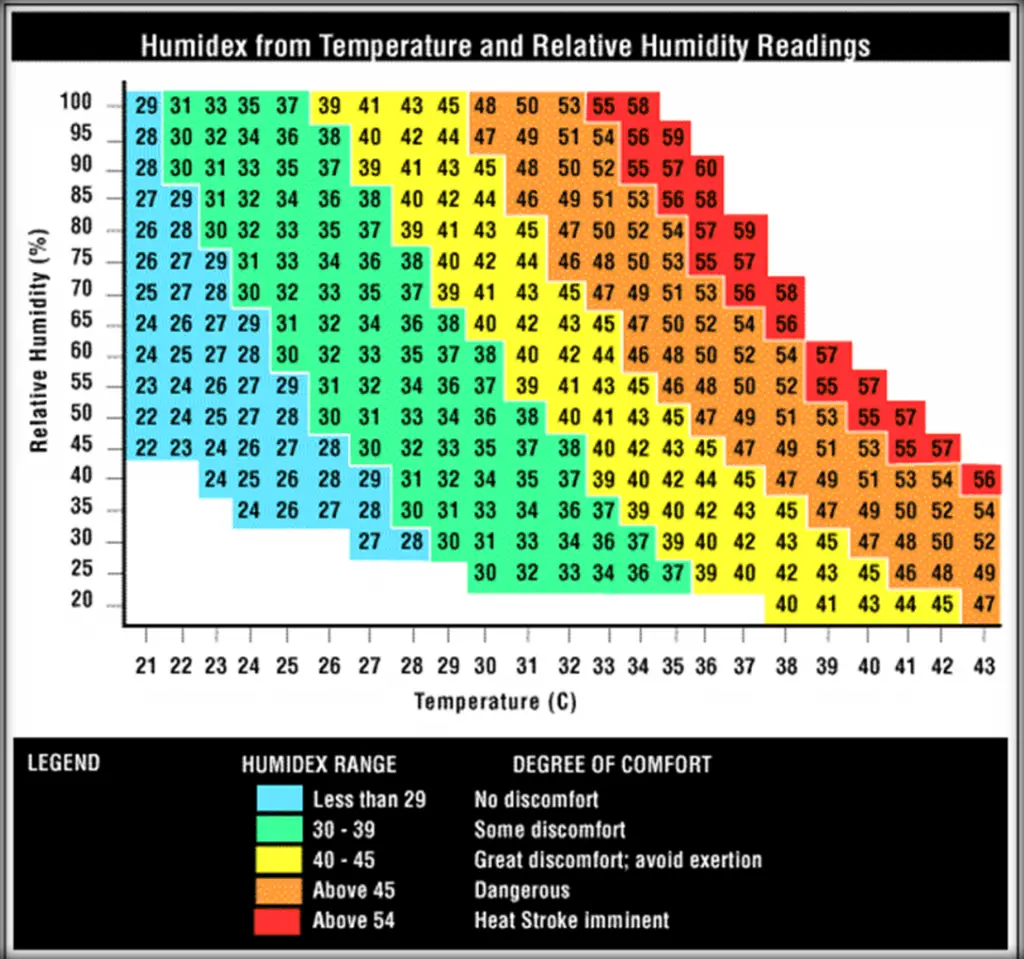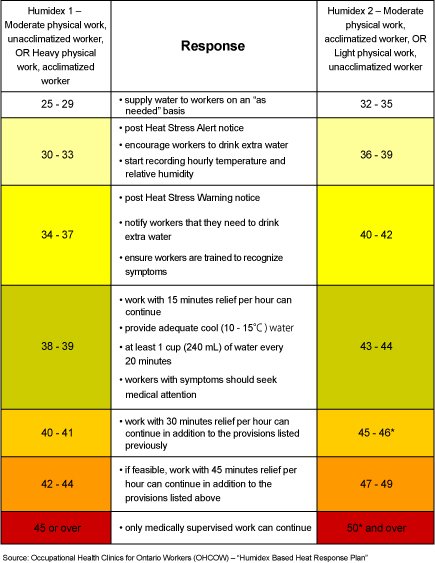Photo of the day: working in heat and Humidex Rating
9 min readWhether it’s a foundry, a bustling restaurant kitchen, or outdoors in the summer months, a hot environment can overwhelm a body’s ability to deal with heat, leading to a variety of illnesses. Whenever possible, employers should take measures to protect workers by avoiding heavy exertion tasks, extreme heat, sun exposure, and high humidity.
The photo of today and below infographic outlines control measures to reduce the effects of heat, along with the signs of heat exhaustion and heat stroke and how employers, workers, and supervisors can take action, In addition, outline Facts about humidex rating and range at work

What is humidex?
Humidex is a measure of how hot we feel. It is a parameter intended for the general public to express how the combined effects of warm temperatures and humidity are perceived. It provides a number that describes how hot people feel, much in the same way the equivalent chill temperature, or “wind chill factor,” describes how cold people feel.
The environment of some countries uses humidex ratings to inform the general public when conditions of heat and humidity are possibly uncomfortable.

The importance of humidity
The body attempts to maintain a constant internal temperature of 37°C at all times. In hot weather, the body produces sweat, which cools the body as it evaporates. As the humidity or the moisture content in the air increases, sweat does not evaporate as readily. Sweat evaporation stops entirely when the relative humidity reaches about 90 percent. Under these circumstances, the body temperature rises and may cause illness.
What are some of the hazards of working in hot environments?
Can workplaces use humidex to monitor conditions that may result in heat-related illness?
Humidex as reported by weather forecasters is intended for the general public to express the combined effects of warm temperatures and humidity.
Heat-related illnesses depend on many workplace factors in addition to air temperature and humidity. Wind speed or air movement, work load, radiant heat sources, and a person’s physical condition are also important.
Under certain workplace conditions, the humidex may serve as an indicator of discomfort resulting from occupational exposures to heat.
For example, when humidity is high, but when work load, wind speed, and radiant heat sources do not significantly contribute to the heat burden, humidex may be useful. Offices are typical of workplaces where humidex could be used. It is important to use the values of the temperature and relative humidity obtained by actual measurements taken in the workplace. Conditions inside the workplace may significantly differ from those given by the Weather Service.
How do I know what the humidex is?
If you know the temperature and relative humidity, the following chart can be used to determine the humidex rating. For example, if the temperature is 30°C and the relative humidity is 70%, the humidex rating is 41. This level is considered a level of “great discomfort” and exertion should be avoided.
See the humidex table for a guide to humidex in comparison to temperature and humidity:
“An extremely high Humidex reading is any reading over 40. In such conditions, you should reduce all unnecessary physical activity. If the reading is in the mid to high 30s, then you should tone down or modify certain types of outdoor exercise, depending on the individual age and health, physical shape, the type of clothes worn and other weather conditions.
If working outdoors is an absolute necessity, drink plenty of liquids and take frequent rest breaks. In hot, humid conditions, there is a considerable risk of heat stroke and sunstroke.”

How is humidex interpreted?
The relation between humidex and comfort is subjective. It varies widely between individuals.
Workplaces must use caution when applying the humidex rating. A high humidex rating can serve as a cue to assess workplace conditions more precisely.
For more information, please see the following articles:
- Tips to reduce heat stress in the workplace
- Howto handle excessive heat exposure at work
- Heat stress-working safely in the heat
The Occupational Health Clinics created a humidex-based response plan that translated the TLVs® WBGTs into humidex values and developed recommended responses for each humidex range. This plan was developed as a tool to help workplaces as most find using the WBGT complicated and expensive.
While technically there is no way to directly compare WBGT and humidex values, this humidex response plan provides an additional guideline that uses information that is easily available to most employers. OHCOW notes, “in the translation process some simplifications and assumptions have been made, therefore, the plan may not be applicable in all circumstances and/or workplaces (follow steps 1 through 5 to ensure the humidex plan is appropriate for your workplace)” which is available on their website
See Table 2 for details.
Notes: These humidex levels are for unacclimatized workers performing moderate physical activity. The ACGIH specifies an action limit and a TLV® to prevent workers’ body temperature from exceeding 38°C (38.5°C for acclimatized workers). Below the action limit (Humidex 1 for work of moderate physical activity) most workers will not experience heat stress. Most healthy, well-hydrated, acclimatized workers not on medications will be able to tolerate heat stress up to the TLV®. (Humidex 2 for moderate physical activity). Between Humidex 1 and Humidex 2, general heat stress controls are needed, and above Humidex 2 job-specific controls are needed.
Table 2
Recommended Actions Based on the Humidex Reading

What index should workplaces use to monitor conditions that may result in heat-related illness?
Occupational (Industrial) hygienists recommend using the Wet Bulb Globe Temperature (WBGT) index to measure workplace conditions. This method closely relates to the human body’s response to heat.
The WBGT measurement takes into account air temperature, air movement, radiant heat, and humidity. There are direct-reading WBGT meters. These are also called “heat-stress indicators,” commercially available. The WBGT measurements can then be related to the physical demands of the job. Only qualified professionals, whether they be in-house staff, consultants, or from the local occupational health and safety regulatory agency, should perform the measurement.
Direct comparison between WBGT and humidex is not possible–there are no conversion tables or mathematical formulas to do such conversions. However, one can estimate WBGT and humidex for a given ambient air temperature and humidity when radiant heat sources (hot and cold surfaces) are absent and air movement is less than 0.5 m/sec. (100 feet per minute). Under these conditions, the globe temperature equals room temperature and the natural wet bulb temperature (on the WBGT apparatus) is approximately 2°F (1.1°C) higher than the wet-bulb temperature measured using a psychrometer.
Standard charts are available to determine wet bulb temperature from given air temperature and relative humidity values. For indoor or outdoor conditions with no direct sunlight, WBGT is calculated by using the following formula:
WBGT = 0.3 x globe temperature + 0.7 x natural wet bulb temperature
Download Infographic
working in heat and Humidex Rating
More Photos
- Photo of the day: 10 Essential Safety Tips for Driving in Hot Weather Conditions
- Photo of the day: best workplace safety tips
- Photo of the day: The Importance of Stop Work Authority in Maintaining Workplace Safety
- Photo of the day: Tomorrow’s Reward for Working Safely Today: Cultivating a Culture of Safety
- Photo of the day: Preventing slips and trips at work
- Photo of the day: Learn the DRSABCD action Plan
- Working with Electricity Electrical Accidents Guide for Electrical Workers
- Photo of the day: Hearing Protection Device Selection
- Photo of the day: If An Earthquake Shakes You-Infographic free
- Fire Safety Posters Free Download
- Photo of the day: First Aid for Electrical Burns-Infographic free
- Infographic: First Aid for Cuts and Scrapes free download
- Photo of The day: Work Safe with Lasers-Laser Safety free
- Photo of the day: Working Safely with chemicals and chemical Management
- Photo of the day: Safe work practices when using MEWPs ( updated)
- Photo of the day: Preventing Common Kitchen Hazards
- Photo of the day: Safe handling of Gas Cylinders and lecture bottles
- Photo of the day: Forklift Stability Triangle
- Photo of the day: Defective Tools Safe Work Practice
- Photo of the day: Lift With Your Legs Not With Your Back
- Photo of the day: First Aid for burns
- Photo of the day: The 7 Principles of HACCP
- Photo of the day: Working Safely with Suspended Loads
- Photo of the day: Heat Stroke First Aid and safety posters
- Photo of the day: Near-Miss Reporting and Posters
- Photo of the day: Ergonomic chair and office chair safety tips
- Photo of the day: Whole Body Vibration
- Photo of the day: Substation Safety Equipment
- Photo of the day: Bypassing Safety Controls Rules
- Photo of the day: Lightning Safety Tips
- Photo of the day: Overhead Power lines Clearance
- Photo of the day: Floor Marking
- Photo of the day: Types of Foot Protection
- Photo of the day: Types of Hand Protection
- Photo of the day: Lockout and Tagout Safety
- Photo of the day: Fall Protection Plans
- Photo of the day: Flood Safety Tips
- Photo of the day: Read All Labels Work safe
- Photo of the day: Run Project safely with Crane Hand Signals
- Photo of the day: Flagman and Traffic control
- Photo of the day: Managing Risks of Exposure to Solvents in the workplace
- Photo of the day: Scissor Lift Safety
- Photo of the day: HSE Bulletin Board
- Photo of the day: Arc-Fault Circuit Interrupters (AFCI)
- Photo of the day: Safe use of ladders and step ladders
- Photo of the day: Concrete Truck Driver Hand Signals
- Photo of the day: Extension Cord Safety Tips
- Photo of the day: Protect your Head
- Photo of the day: choosing the right Anchorage
- Photo of the day: Work-Related Asthma
- Photo of the day: Top FIVE Heavy Equipment Construction Site Safety Tips
- Photo of the day: sun safety in the workplace
- Photo of the day: Cannabis and Impairment in the Workplace
- Photo of the day: Position for safety and comfort-Safety Tips
- Photo of the day: Generator Safety
- Photo of the day: Controlling COVID-19 in the Workplace-Physical Barriers
- Photo of the day: Manual Material handling
- Photo of the day: Personal Protective Equipment last resort
- Photo of the day: WHMIS 2015 – Pictograms
- Photo of the day: Indoor Air Quality
- Photo of the day: Noise in the affected workplace
- Photo of the day: Fatigue at Work
- Photo of the day: Don’t be Driven to Distraction
- Photo of the day: working in heat and Humidex Rating
- How to use Plate Clamps Safely: Safety Moment#34
- Photo of the day: Sitting at work
- Photo of the day: 5 ways to reduce the risk of Slipping and Tripping
- Photo of the day: Preventing the spread of contagious illness
- Photo of the day: Incident Investigations
- Photo of the day: 10 Scaffold Safety Essentials
- Photo of the day: Effective Health and Safety Committees
- Photo of the day: New worker Orientation & Safety Orientation checklist
- Photo of the day: Workplace Inspection
- Photo of the day: musculoskeletal disorders
- Photo of the day: Emergency preparedness in the workplace
- Photo of the day: Mental health in the workplace
- Photo of the day: Trenching Safety Tips That Can Save a Life
- Photo of the day: Dangerous Goods Classes
- Photo of the day: Safety Equipment for Confined Spaces
- Photo of the day: Tips to reduce Heat stress in the workplace
- Photo of the day: hierarchy of controls
- Your steps to chemical safety
- H2S Gas and how to handle its Emergency
- Photo of the day: Importance of Mock drill and Fire Action Emergency Procedure
- Photo of the day: Choosing the Right Face Mask and the difference between a respirator and face mask
- Photo of the day: Confined space safety Precautions
- Breath Safely: The Proper Use of Respiratory Protection
- Photo of the day: Electric shock survival
- Photo of the day: Chemical Spill Emergency Response
- Photo of the day: Construction Site fire Safety
- Photo of the day: Confined Space rescue



